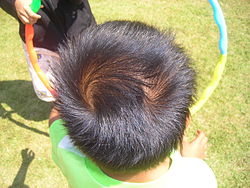Cowlick

A cowlick is a section of hair that stands straight up or lies at an angle at odds with the style in which the rest of an individual's hair is worn. Cowlicks appear when the growth direction of the hair forms in (against) the spiral pattern. The term "cowlick" originates from the domestic bovine's habit of licking its young, which results in a swirling pattern in the hair.[citation needed] The most common site of a human cowlick is in the crown, but they can show up anywhere. They also sometimes appear in the front and back of the head.[1]
The term "cowlick" dates from the late 16th century, when used it in his translation of Gian Paolo Lomazzo: "The lockes or plaine feakes of haire called cow-lickes, are made turning upwards."[2]
Characteristics[]
Hair on the back of the head usually grows in a circular flattened pattern from a central point; this can also occur on facial hair. The definition of a whorl is hairs that rotate round an axis.[3] The point where the hair whorl is found is the spot where the hair changes direction. On top of the head hair grows to the front, on the back of the head it grows towards the nape and hair grows to the left and right side of the head on the sides of the head. The hair whorl can be in the center of the head but it can also be located to the left or right side of the head. In the very center of the scalp it will be visible because the hair lies flat.
People with cowlicks tend to have at least two hair whorls with one being dominant and clearly visible while the other is less obvious.[citation needed] In the center of the hair whorl you can see the hairs protruding from the scalp. When combed against the grain of the hair, the hair in the center of the cowlick will stand up straight. When left too long, the cowlick will create a flat spot, when left too short it will stand up.
Cowlicks are more obvious in straight, thick hair.[citation needed] In people with straight, coarse hair the scalp will show in the center of the whorl because the light penetrates to the scalp. Cowlicks appear on people of any sex.[citation needed]
Scientists who have studied cowlicks believe genes largely determine their location and number.[citation needed] Usually, the most visible cowlick can be found at the top of the head. Other cowlicks might also be located at the front hairline where the hair is parted or in the back close to the neckline. Whether you're right-handed or left-handed might also be associated with whether your cowlicks swirl in a clockwise or counterclockwise direction.[dubious ] Scientists have found an interesting connection between cowlicks and handedness.[citation needed] Right-handed people tend to have cowlicks that have a clockwise spiral pattern, conversely, left-handed people are more likely to have counterclockwise cowlicks.[citation needed]
Management[]
Many people find cowlicks irritating as they often conflict with the desired hairstyle.[citation needed] There are several ways to tame an unruly cowlick.[citation needed] For most people, a combination of the right hairstyle, length, product used, and styling technique can overcome the appearance.[citation needed] For people who are more concerned about cowlick management, more drastic measures may be used. Electrology, waxing, and even cosmetic surgery can be used to more permanently correct the cowlick.[4] However, many people have also used their cowlicks to their advantage,[citation needed] especially for those having cowlicks at the hairline which can make it easier to style a pompadour.[citation needed]
See also[]
- Ahoge
- Hair whorl
- Hairy ball theorem
References[]
| Wikimedia Commons has media related to Cowlicks. |
- ^ The Dreaded Cowlick ! - Hair
- ^ Take Our Word For It Issue 76
- ^ Ziering, Follow Hair Whorl. Skin And Allergy News
- ^ Problem Hair: Cowlicks
- Hairdressing